Case Study Analysis: Alan Jones, BPH, TURP Surgery, and Interventions
VerifiedAdded on 2020/02/24
|9
|2567
|128
Case Study
AI Summary
This case study focuses on Alan Jones, a patient admitted with Benign Prostatic Hyperplasia (BPH) requiring Transurethral Resection of the Prostate (TURP) surgery. The analysis includes the etiology and pathophysiology of BPH, emphasizing its link to aging and potential risk factors like diabetes and obesity. The study details the surgical procedure, post-operative complications such as hematuria and vital sign abnormalities (hypothermia, tachycardia, and tachypnea), and the necessary nursing interventions to address these issues. A key aspect is the importance of a multidisciplinary team, including dieticians, diabetes educators, and substance abuse counselors, to provide comprehensive patient care. The case highlights the roles of each team member in promoting patient recovery, emphasizing the need for clear communication and coordinated care to ensure a positive outcome for Alan Jones.

CASE STUDY
ALAN JONES
Author note:
ALAN JONES
Author note:
Paraphrase This Document
Need a fresh take? Get an instant paraphrase of this document with our AI Paraphraser
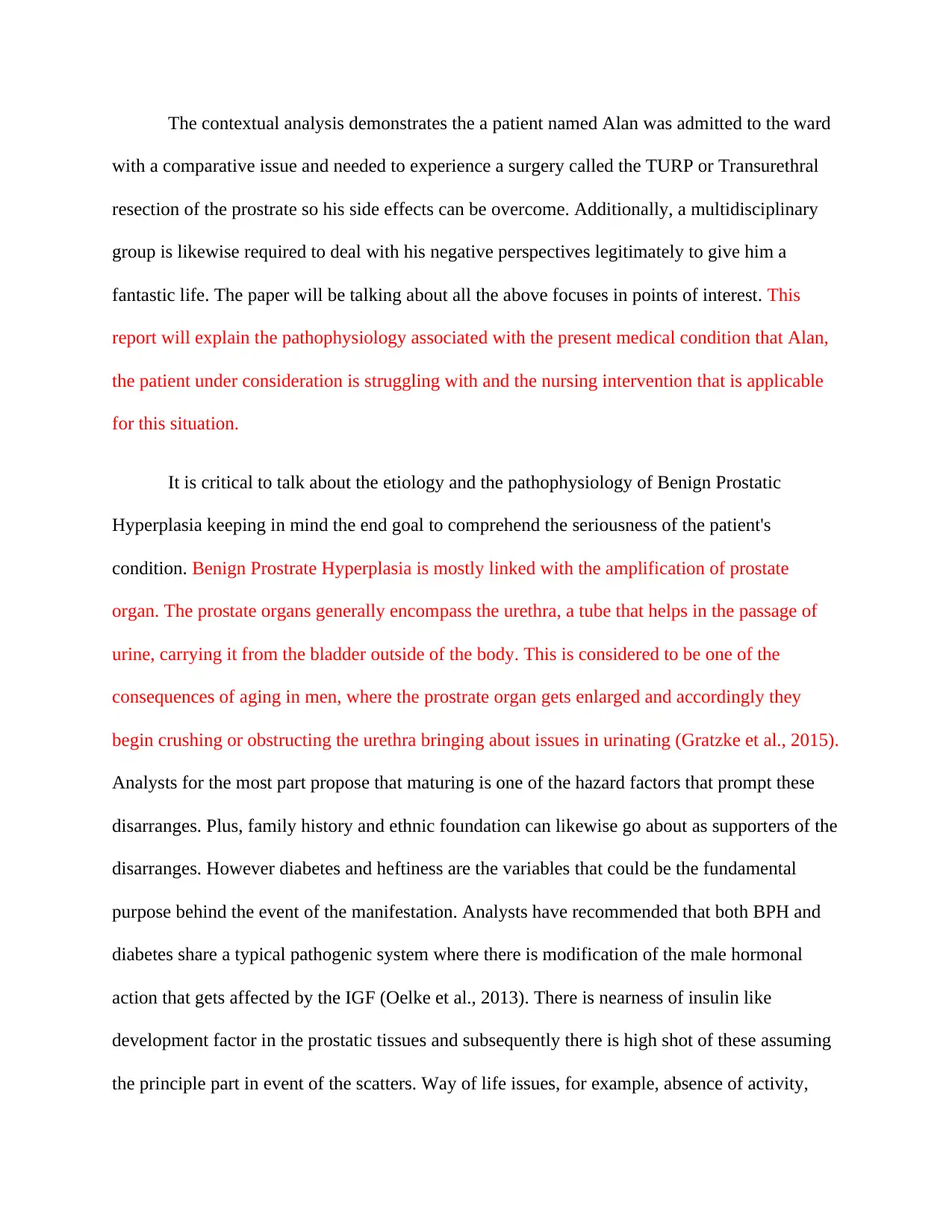
The contextual analysis demonstrates the a patient named Alan was admitted to the ward
with a comparative issue and needed to experience a surgery called the TURP or Transurethral
resection of the prostrate so his side effects can be overcome. Additionally, a multidisciplinary
group is likewise required to deal with his negative perspectives legitimately to give him a
fantastic life. The paper will be talking about all the above focuses in points of interest. This
report will explain the pathophysiology associated with the present medical condition that Alan,
the patient under consideration is struggling with and the nursing intervention that is applicable
for this situation.
It is critical to talk about the etiology and the pathophysiology of Benign Prostatic
Hyperplasia keeping in mind the end goal to comprehend the seriousness of the patient's
condition. Benign Prostrate Hyperplasia is mostly linked with the amplification of prostate
organ. The prostate organs generally encompass the urethra, a tube that helps in the passage of
urine, carrying it from the bladder outside of the body. This is considered to be one of the
consequences of aging in men, where the prostrate organ gets enlarged and accordingly they
begin crushing or obstructing the urethra bringing about issues in urinating (Gratzke et al., 2015).
Analysts for the most part propose that maturing is one of the hazard factors that prompt these
disarranges. Plus, family history and ethnic foundation can likewise go about as supporters of the
disarranges. However diabetes and heftiness are the variables that could be the fundamental
purpose behind the event of the manifestation. Analysts have recommended that both BPH and
diabetes share a typical pathogenic system where there is modification of the male hormonal
action that gets affected by the IGF (Oelke et al., 2013). There is nearness of insulin like
development factor in the prostatic tissues and subsequently there is high shot of these assuming
the principle part in event of the scatters. Way of life issues, for example, absence of activity,
with a comparative issue and needed to experience a surgery called the TURP or Transurethral
resection of the prostrate so his side effects can be overcome. Additionally, a multidisciplinary
group is likewise required to deal with his negative perspectives legitimately to give him a
fantastic life. The paper will be talking about all the above focuses in points of interest. This
report will explain the pathophysiology associated with the present medical condition that Alan,
the patient under consideration is struggling with and the nursing intervention that is applicable
for this situation.
It is critical to talk about the etiology and the pathophysiology of Benign Prostatic
Hyperplasia keeping in mind the end goal to comprehend the seriousness of the patient's
condition. Benign Prostrate Hyperplasia is mostly linked with the amplification of prostate
organ. The prostate organs generally encompass the urethra, a tube that helps in the passage of
urine, carrying it from the bladder outside of the body. This is considered to be one of the
consequences of aging in men, where the prostrate organ gets enlarged and accordingly they
begin crushing or obstructing the urethra bringing about issues in urinating (Gratzke et al., 2015).
Analysts for the most part propose that maturing is one of the hazard factors that prompt these
disarranges. Plus, family history and ethnic foundation can likewise go about as supporters of the
disarranges. However diabetes and heftiness are the variables that could be the fundamental
purpose behind the event of the manifestation. Analysts have recommended that both BPH and
diabetes share a typical pathogenic system where there is modification of the male hormonal
action that gets affected by the IGF (Oelke et al., 2013). There is nearness of insulin like
development factor in the prostatic tissues and subsequently there is high shot of these assuming
the principle part in event of the scatters. Way of life issues, for example, absence of activity,
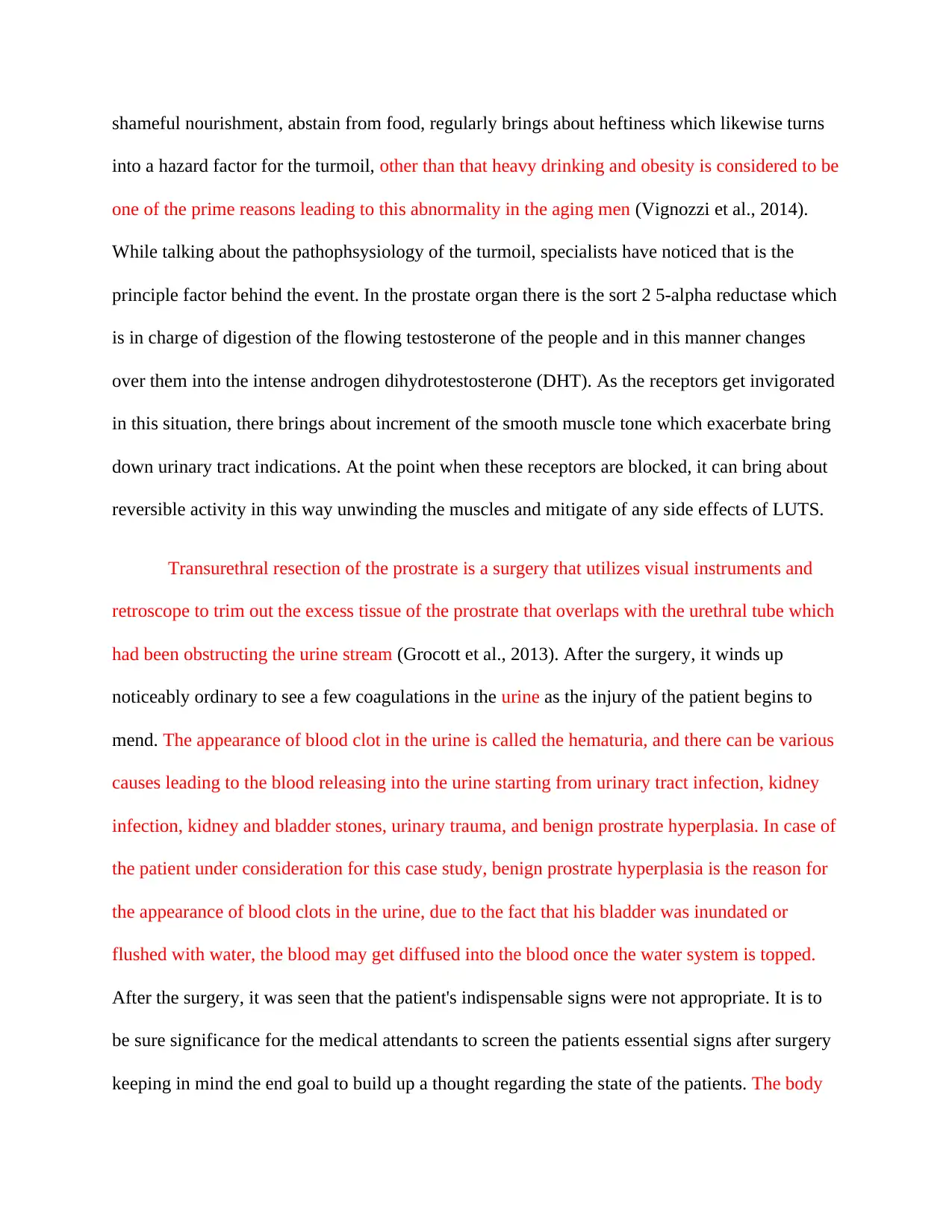
shameful nourishment, abstain from food, regularly brings about heftiness which likewise turns
into a hazard factor for the turmoil, other than that heavy drinking and obesity is considered to be
one of the prime reasons leading to this abnormality in the aging men (Vignozzi et al., 2014).
While talking about the pathophsysiology of the turmoil, specialists have noticed that is the
principle factor behind the event. In the prostate organ there is the sort 2 5-alpha reductase which
is in charge of digestion of the flowing testosterone of the people and in this manner changes
over them into the intense androgen dihydrotestosterone (DHT). As the receptors get invigorated
in this situation, there brings about increment of the smooth muscle tone which exacerbate bring
down urinary tract indications. At the point when these receptors are blocked, it can bring about
reversible activity in this way unwinding the muscles and mitigate of any side effects of LUTS.
Transurethral resection of the prostrate is a surgery that utilizes visual instruments and
retroscope to trim out the excess tissue of the prostrate that overlaps with the urethral tube which
had been obstructing the urine stream (Grocott et al., 2013). After the surgery, it winds up
noticeably ordinary to see a few coagulations in the urine as the injury of the patient begins to
mend. The appearance of blood clot in the urine is called the hematuria, and there can be various
causes leading to the blood releasing into the urine starting from urinary tract infection, kidney
infection, kidney and bladder stones, urinary trauma, and benign prostrate hyperplasia. In case of
the patient under consideration for this case study, benign prostrate hyperplasia is the reason for
the appearance of blood clots in the urine, due to the fact that his bladder was inundated or
flushed with water, the blood may get diffused into the blood once the water system is topped.
After the surgery, it was seen that the patient's indispensable signs were not appropriate. It is to
be sure significance for the medical attendants to screen the patients essential signs after surgery
keeping in mind the end goal to build up a thought regarding the state of the patients. The body
into a hazard factor for the turmoil, other than that heavy drinking and obesity is considered to be
one of the prime reasons leading to this abnormality in the aging men (Vignozzi et al., 2014).
While talking about the pathophsysiology of the turmoil, specialists have noticed that is the
principle factor behind the event. In the prostate organ there is the sort 2 5-alpha reductase which
is in charge of digestion of the flowing testosterone of the people and in this manner changes
over them into the intense androgen dihydrotestosterone (DHT). As the receptors get invigorated
in this situation, there brings about increment of the smooth muscle tone which exacerbate bring
down urinary tract indications. At the point when these receptors are blocked, it can bring about
reversible activity in this way unwinding the muscles and mitigate of any side effects of LUTS.
Transurethral resection of the prostrate is a surgery that utilizes visual instruments and
retroscope to trim out the excess tissue of the prostrate that overlaps with the urethral tube which
had been obstructing the urine stream (Grocott et al., 2013). After the surgery, it winds up
noticeably ordinary to see a few coagulations in the urine as the injury of the patient begins to
mend. The appearance of blood clot in the urine is called the hematuria, and there can be various
causes leading to the blood releasing into the urine starting from urinary tract infection, kidney
infection, kidney and bladder stones, urinary trauma, and benign prostrate hyperplasia. In case of
the patient under consideration for this case study, benign prostrate hyperplasia is the reason for
the appearance of blood clots in the urine, due to the fact that his bladder was inundated or
flushed with water, the blood may get diffused into the blood once the water system is topped.
After the surgery, it was seen that the patient's indispensable signs were not appropriate. It is to
be sure significance for the medical attendants to screen the patients essential signs after surgery
keeping in mind the end goal to build up a thought regarding the state of the patients. The body
⊘ This is a preview!⊘
Do you want full access?
Subscribe today to unlock all pages.

Trusted by 1+ million students worldwide
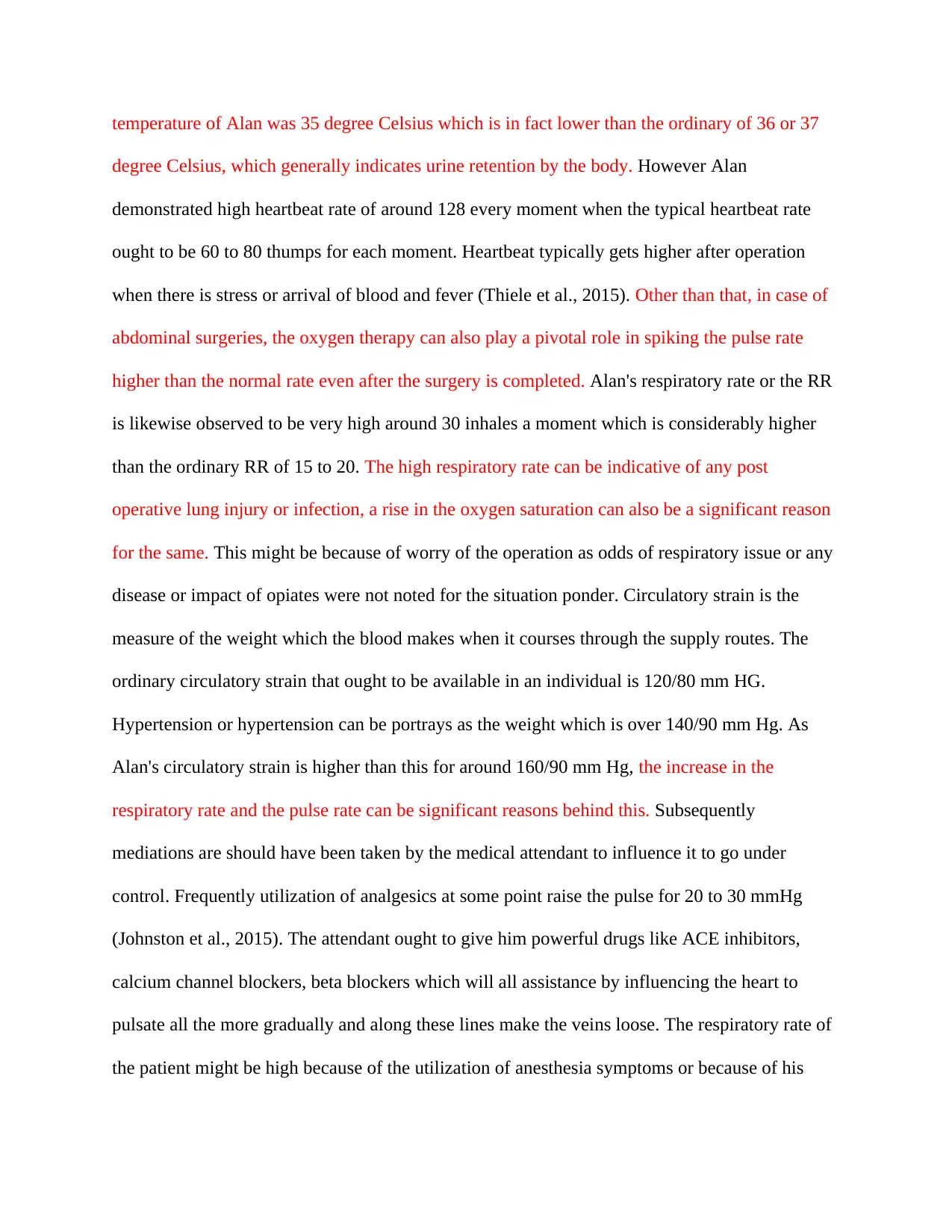
temperature of Alan was 35 degree Celsius which is in fact lower than the ordinary of 36 or 37
degree Celsius, which generally indicates urine retention by the body. However Alan
demonstrated high heartbeat rate of around 128 every moment when the typical heartbeat rate
ought to be 60 to 80 thumps for each moment. Heartbeat typically gets higher after operation
when there is stress or arrival of blood and fever (Thiele et al., 2015). Other than that, in case of
abdominal surgeries, the oxygen therapy can also play a pivotal role in spiking the pulse rate
higher than the normal rate even after the surgery is completed. Alan's respiratory rate or the RR
is likewise observed to be very high around 30 inhales a moment which is considerably higher
than the ordinary RR of 15 to 20. The high respiratory rate can be indicative of any post
operative lung injury or infection, a rise in the oxygen saturation can also be a significant reason
for the same. This might be because of worry of the operation as odds of respiratory issue or any
disease or impact of opiates were not noted for the situation ponder. Circulatory strain is the
measure of the weight which the blood makes when it courses through the supply routes. The
ordinary circulatory strain that ought to be available in an individual is 120/80 mm HG.
Hypertension or hypertension can be portrays as the weight which is over 140/90 mm Hg. As
Alan's circulatory strain is higher than this for around 160/90 mm Hg, the increase in the
respiratory rate and the pulse rate can be significant reasons behind this. Subsequently
mediations are should have been taken by the medical attendant to influence it to go under
control. Frequently utilization of analgesics at some point raise the pulse for 20 to 30 mmHg
(Johnston et al., 2015). The attendant ought to give him powerful drugs like ACE inhibitors,
calcium channel blockers, beta blockers which will all assistance by influencing the heart to
pulsate all the more gradually and along these lines make the veins loose. The respiratory rate of
the patient might be high because of the utilization of anesthesia symptoms or because of his
degree Celsius, which generally indicates urine retention by the body. However Alan
demonstrated high heartbeat rate of around 128 every moment when the typical heartbeat rate
ought to be 60 to 80 thumps for each moment. Heartbeat typically gets higher after operation
when there is stress or arrival of blood and fever (Thiele et al., 2015). Other than that, in case of
abdominal surgeries, the oxygen therapy can also play a pivotal role in spiking the pulse rate
higher than the normal rate even after the surgery is completed. Alan's respiratory rate or the RR
is likewise observed to be very high around 30 inhales a moment which is considerably higher
than the ordinary RR of 15 to 20. The high respiratory rate can be indicative of any post
operative lung injury or infection, a rise in the oxygen saturation can also be a significant reason
for the same. This might be because of worry of the operation as odds of respiratory issue or any
disease or impact of opiates were not noted for the situation ponder. Circulatory strain is the
measure of the weight which the blood makes when it courses through the supply routes. The
ordinary circulatory strain that ought to be available in an individual is 120/80 mm HG.
Hypertension or hypertension can be portrays as the weight which is over 140/90 mm Hg. As
Alan's circulatory strain is higher than this for around 160/90 mm Hg, the increase in the
respiratory rate and the pulse rate can be significant reasons behind this. Subsequently
mediations are should have been taken by the medical attendant to influence it to go under
control. Frequently utilization of analgesics at some point raise the pulse for 20 to 30 mmHg
(Johnston et al., 2015). The attendant ought to give him powerful drugs like ACE inhibitors,
calcium channel blockers, beta blockers which will all assistance by influencing the heart to
pulsate all the more gradually and along these lines make the veins loose. The respiratory rate of
the patient might be high because of the utilization of anesthesia symptoms or because of his
Paraphrase This Document
Need a fresh take? Get an instant paraphrase of this document with our AI Paraphraser
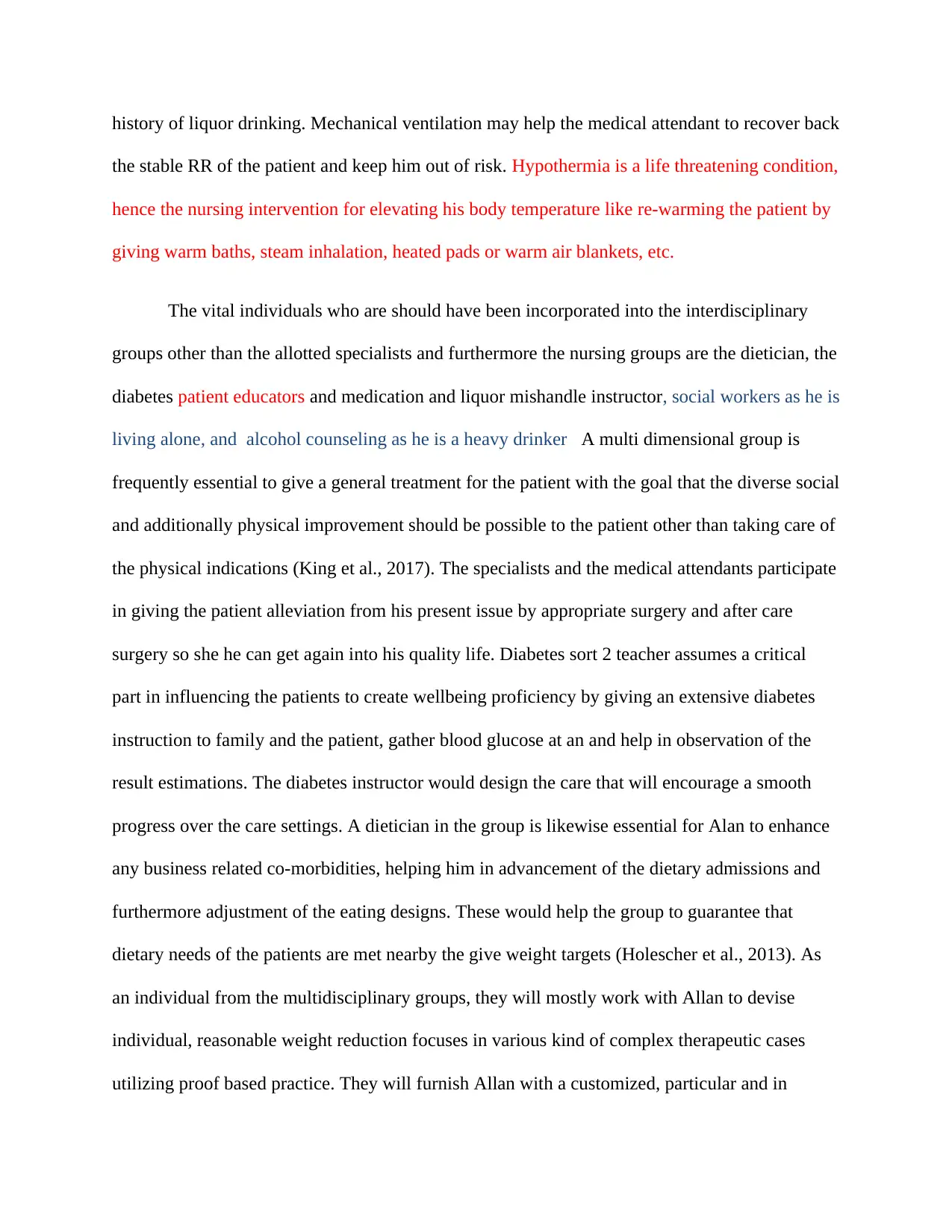
history of liquor drinking. Mechanical ventilation may help the medical attendant to recover back
the stable RR of the patient and keep him out of risk. Hypothermia is a life threatening condition,
hence the nursing intervention for elevating his body temperature like re-warming the patient by
giving warm baths, steam inhalation, heated pads or warm air blankets, etc.
The vital individuals who are should have been incorporated into the interdisciplinary
groups other than the allotted specialists and furthermore the nursing groups are the dietician, the
diabetes patient educators and medication and liquor mishandle instructor, social workers as he is
living alone, and alcohol counseling as he is a heavy drinker A multi dimensional group is
frequently essential to give a general treatment for the patient with the goal that the diverse social
and additionally physical improvement should be possible to the patient other than taking care of
the physical indications (King et al., 2017). The specialists and the medical attendants participate
in giving the patient alleviation from his present issue by appropriate surgery and after care
surgery so she he can get again into his quality life. Diabetes sort 2 teacher assumes a critical
part in influencing the patients to create wellbeing proficiency by giving an extensive diabetes
instruction to family and the patient, gather blood glucose at an and help in observation of the
result estimations. The diabetes instructor would design the care that will encourage a smooth
progress over the care settings. A dietician in the group is likewise essential for Alan to enhance
any business related co-morbidities, helping him in advancement of the dietary admissions and
furthermore adjustment of the eating designs. These would help the group to guarantee that
dietary needs of the patients are met nearby the give weight targets (Holescher et al., 2013). As
an individual from the multidisciplinary groups, they will mostly work with Allan to devise
individual, reasonable weight reduction focuses in various kind of complex therapeutic cases
utilizing proof based practice. They will furnish Allan with a customized, particular and in
the stable RR of the patient and keep him out of risk. Hypothermia is a life threatening condition,
hence the nursing intervention for elevating his body temperature like re-warming the patient by
giving warm baths, steam inhalation, heated pads or warm air blankets, etc.
The vital individuals who are should have been incorporated into the interdisciplinary
groups other than the allotted specialists and furthermore the nursing groups are the dietician, the
diabetes patient educators and medication and liquor mishandle instructor, social workers as he is
living alone, and alcohol counseling as he is a heavy drinker A multi dimensional group is
frequently essential to give a general treatment for the patient with the goal that the diverse social
and additionally physical improvement should be possible to the patient other than taking care of
the physical indications (King et al., 2017). The specialists and the medical attendants participate
in giving the patient alleviation from his present issue by appropriate surgery and after care
surgery so she he can get again into his quality life. Diabetes sort 2 teacher assumes a critical
part in influencing the patients to create wellbeing proficiency by giving an extensive diabetes
instruction to family and the patient, gather blood glucose at an and help in observation of the
result estimations. The diabetes instructor would design the care that will encourage a smooth
progress over the care settings. A dietician in the group is likewise essential for Alan to enhance
any business related co-morbidities, helping him in advancement of the dietary admissions and
furthermore adjustment of the eating designs. These would help the group to guarantee that
dietary needs of the patients are met nearby the give weight targets (Holescher et al., 2013). As
an individual from the multidisciplinary groups, they will mostly work with Allan to devise
individual, reasonable weight reduction focuses in various kind of complex therapeutic cases
utilizing proof based practice. They will furnish Allan with a customized, particular and in
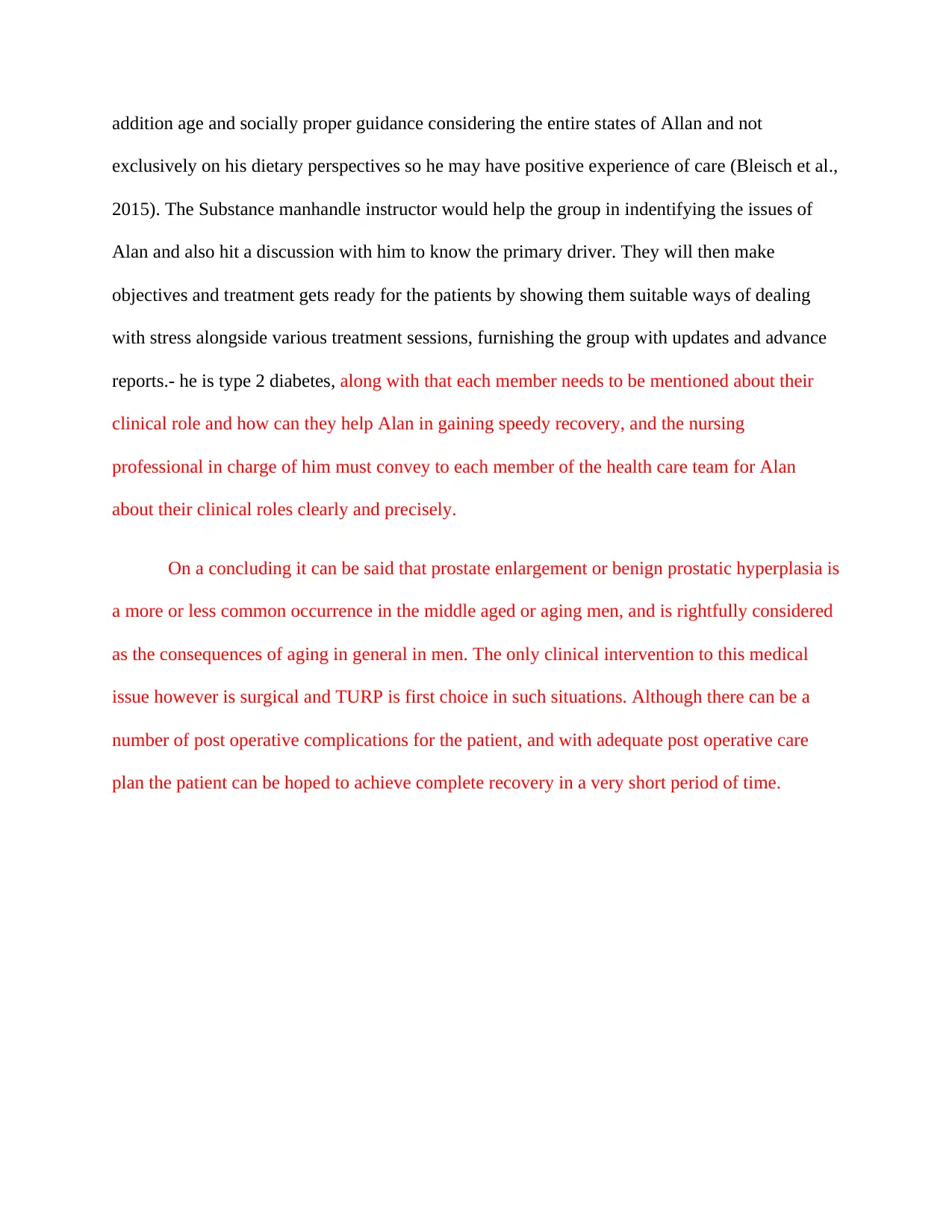
addition age and socially proper guidance considering the entire states of Allan and not
exclusively on his dietary perspectives so he may have positive experience of care (Bleisch et al.,
2015). The Substance manhandle instructor would help the group in indentifying the issues of
Alan and also hit a discussion with him to know the primary driver. They will then make
objectives and treatment gets ready for the patients by showing them suitable ways of dealing
with stress alongside various treatment sessions, furnishing the group with updates and advance
reports.- he is type 2 diabetes, along with that each member needs to be mentioned about their
clinical role and how can they help Alan in gaining speedy recovery, and the nursing
professional in charge of him must convey to each member of the health care team for Alan
about their clinical roles clearly and precisely.
On a concluding it can be said that prostate enlargement or benign prostatic hyperplasia is
a more or less common occurrence in the middle aged or aging men, and is rightfully considered
as the consequences of aging in general in men. The only clinical intervention to this medical
issue however is surgical and TURP is first choice in such situations. Although there can be a
number of post operative complications for the patient, and with adequate post operative care
plan the patient can be hoped to achieve complete recovery in a very short period of time.
exclusively on his dietary perspectives so he may have positive experience of care (Bleisch et al.,
2015). The Substance manhandle instructor would help the group in indentifying the issues of
Alan and also hit a discussion with him to know the primary driver. They will then make
objectives and treatment gets ready for the patients by showing them suitable ways of dealing
with stress alongside various treatment sessions, furnishing the group with updates and advance
reports.- he is type 2 diabetes, along with that each member needs to be mentioned about their
clinical role and how can they help Alan in gaining speedy recovery, and the nursing
professional in charge of him must convey to each member of the health care team for Alan
about their clinical roles clearly and precisely.
On a concluding it can be said that prostate enlargement or benign prostatic hyperplasia is
a more or less common occurrence in the middle aged or aging men, and is rightfully considered
as the consequences of aging in general in men. The only clinical intervention to this medical
issue however is surgical and TURP is first choice in such situations. Although there can be a
number of post operative complications for the patient, and with adequate post operative care
plan the patient can be hoped to achieve complete recovery in a very short period of time.
⊘ This is a preview!⊘
Do you want full access?
Subscribe today to unlock all pages.

Trusted by 1+ million students worldwide
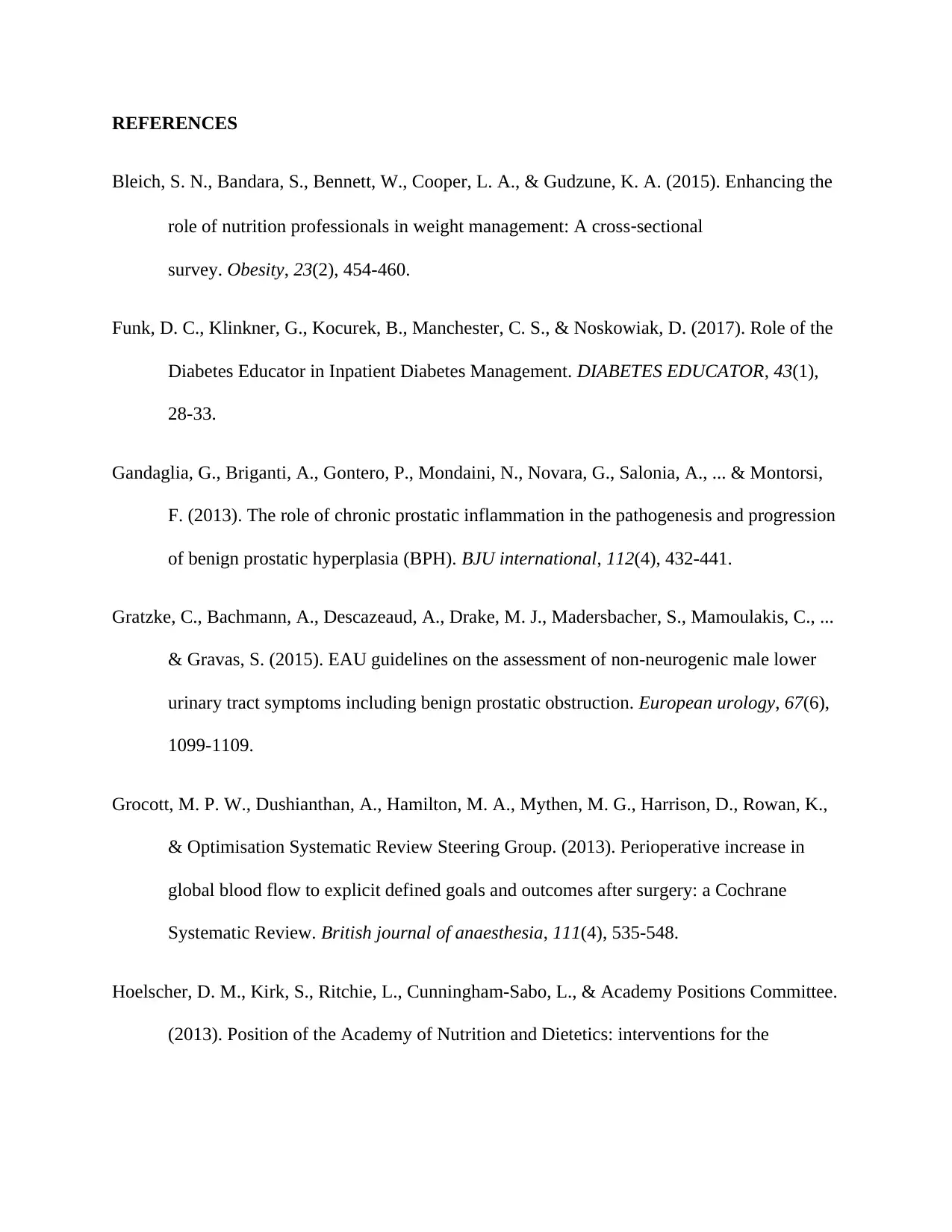
REFERENCES
Bleich, S. N., Bandara, S., Bennett, W., Cooper, L. A., & Gudzune, K. A. (2015). Enhancing the
role of nutrition professionals in weight management: A cross‐sectional
survey. Obesity, 23(2), 454-460.
Funk, D. C., Klinkner, G., Kocurek, B., Manchester, C. S., & Noskowiak, D. (2017). Role of the
Diabetes Educator in Inpatient Diabetes Management. DIABETES EDUCATOR, 43(1),
28-33.
Gandaglia, G., Briganti, A., Gontero, P., Mondaini, N., Novara, G., Salonia, A., ... & Montorsi,
F. (2013). The role of chronic prostatic inflammation in the pathogenesis and progression
of benign prostatic hyperplasia (BPH). BJU international, 112(4), 432-441.
Gratzke, C., Bachmann, A., Descazeaud, A., Drake, M. J., Madersbacher, S., Mamoulakis, C., ...
& Gravas, S. (2015). EAU guidelines on the assessment of non-neurogenic male lower
urinary tract symptoms including benign prostatic obstruction. European urology, 67(6),
1099-1109.
Grocott, M. P. W., Dushianthan, A., Hamilton, M. A., Mythen, M. G., Harrison, D., Rowan, K.,
& Optimisation Systematic Review Steering Group. (2013). Perioperative increase in
global blood flow to explicit defined goals and outcomes after surgery: a Cochrane
Systematic Review. British journal of anaesthesia, 111(4), 535-548.
Hoelscher, D. M., Kirk, S., Ritchie, L., Cunningham-Sabo, L., & Academy Positions Committee.
(2013). Position of the Academy of Nutrition and Dietetics: interventions for the
Bleich, S. N., Bandara, S., Bennett, W., Cooper, L. A., & Gudzune, K. A. (2015). Enhancing the
role of nutrition professionals in weight management: A cross‐sectional
survey. Obesity, 23(2), 454-460.
Funk, D. C., Klinkner, G., Kocurek, B., Manchester, C. S., & Noskowiak, D. (2017). Role of the
Diabetes Educator in Inpatient Diabetes Management. DIABETES EDUCATOR, 43(1),
28-33.
Gandaglia, G., Briganti, A., Gontero, P., Mondaini, N., Novara, G., Salonia, A., ... & Montorsi,
F. (2013). The role of chronic prostatic inflammation in the pathogenesis and progression
of benign prostatic hyperplasia (BPH). BJU international, 112(4), 432-441.
Gratzke, C., Bachmann, A., Descazeaud, A., Drake, M. J., Madersbacher, S., Mamoulakis, C., ...
& Gravas, S. (2015). EAU guidelines on the assessment of non-neurogenic male lower
urinary tract symptoms including benign prostatic obstruction. European urology, 67(6),
1099-1109.
Grocott, M. P. W., Dushianthan, A., Hamilton, M. A., Mythen, M. G., Harrison, D., Rowan, K.,
& Optimisation Systematic Review Steering Group. (2013). Perioperative increase in
global blood flow to explicit defined goals and outcomes after surgery: a Cochrane
Systematic Review. British journal of anaesthesia, 111(4), 535-548.
Hoelscher, D. M., Kirk, S., Ritchie, L., Cunningham-Sabo, L., & Academy Positions Committee.
(2013). Position of the Academy of Nutrition and Dietetics: interventions for the
Paraphrase This Document
Need a fresh take? Get an instant paraphrase of this document with our AI Paraphraser
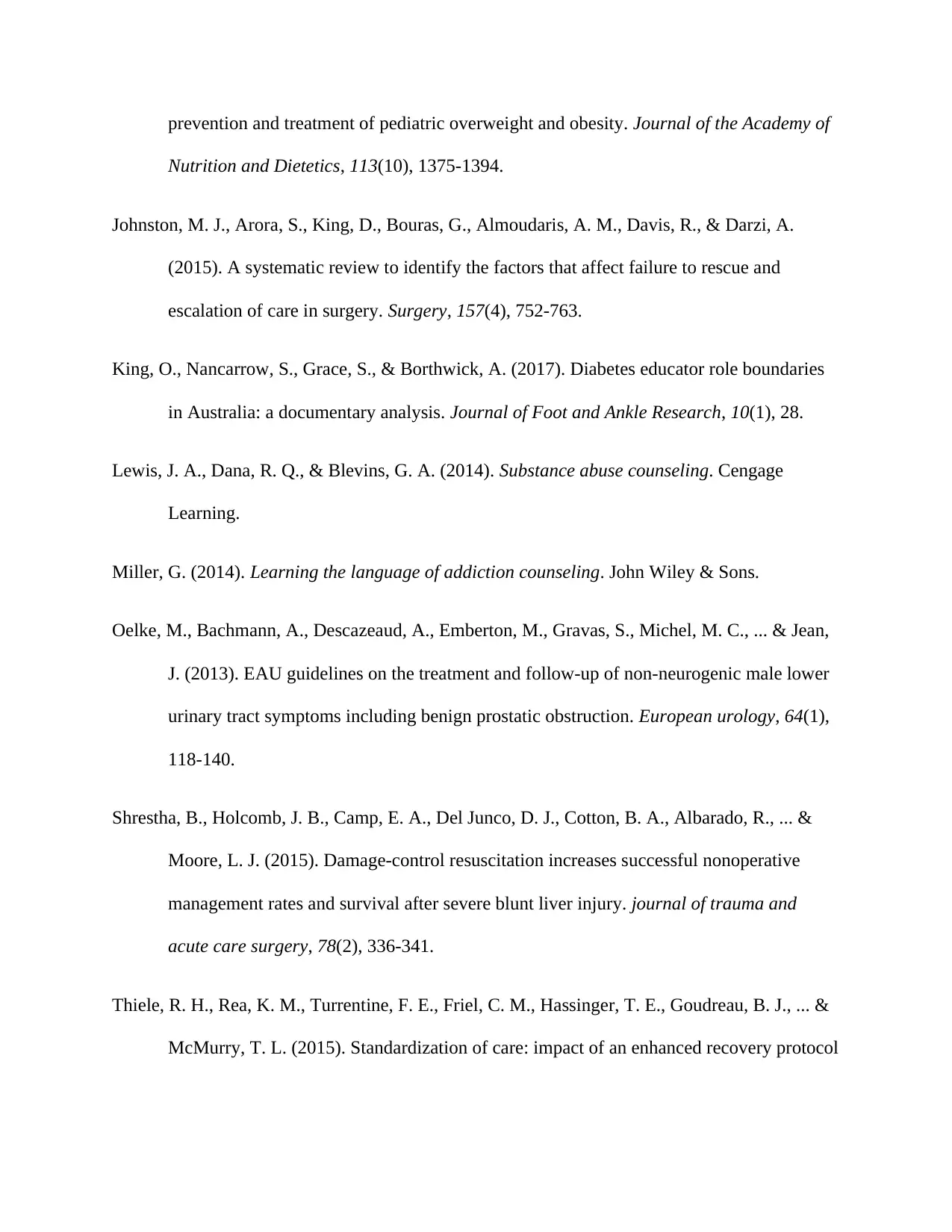
prevention and treatment of pediatric overweight and obesity. Journal of the Academy of
Nutrition and Dietetics, 113(10), 1375-1394.
Johnston, M. J., Arora, S., King, D., Bouras, G., Almoudaris, A. M., Davis, R., & Darzi, A.
(2015). A systematic review to identify the factors that affect failure to rescue and
escalation of care in surgery. Surgery, 157(4), 752-763.
King, O., Nancarrow, S., Grace, S., & Borthwick, A. (2017). Diabetes educator role boundaries
in Australia: a documentary analysis. Journal of Foot and Ankle Research, 10(1), 28.
Lewis, J. A., Dana, R. Q., & Blevins, G. A. (2014). Substance abuse counseling. Cengage
Learning.
Miller, G. (2014). Learning the language of addiction counseling. John Wiley & Sons.
Oelke, M., Bachmann, A., Descazeaud, A., Emberton, M., Gravas, S., Michel, M. C., ... & Jean,
J. (2013). EAU guidelines on the treatment and follow-up of non-neurogenic male lower
urinary tract symptoms including benign prostatic obstruction. European urology, 64(1),
118-140.
Shrestha, B., Holcomb, J. B., Camp, E. A., Del Junco, D. J., Cotton, B. A., Albarado, R., ... &
Moore, L. J. (2015). Damage-control resuscitation increases successful nonoperative
management rates and survival after severe blunt liver injury. journal of trauma and
acute care surgery, 78(2), 336-341.
Thiele, R. H., Rea, K. M., Turrentine, F. E., Friel, C. M., Hassinger, T. E., Goudreau, B. J., ... &
McMurry, T. L. (2015). Standardization of care: impact of an enhanced recovery protocol
Nutrition and Dietetics, 113(10), 1375-1394.
Johnston, M. J., Arora, S., King, D., Bouras, G., Almoudaris, A. M., Davis, R., & Darzi, A.
(2015). A systematic review to identify the factors that affect failure to rescue and
escalation of care in surgery. Surgery, 157(4), 752-763.
King, O., Nancarrow, S., Grace, S., & Borthwick, A. (2017). Diabetes educator role boundaries
in Australia: a documentary analysis. Journal of Foot and Ankle Research, 10(1), 28.
Lewis, J. A., Dana, R. Q., & Blevins, G. A. (2014). Substance abuse counseling. Cengage
Learning.
Miller, G. (2014). Learning the language of addiction counseling. John Wiley & Sons.
Oelke, M., Bachmann, A., Descazeaud, A., Emberton, M., Gravas, S., Michel, M. C., ... & Jean,
J. (2013). EAU guidelines on the treatment and follow-up of non-neurogenic male lower
urinary tract symptoms including benign prostatic obstruction. European urology, 64(1),
118-140.
Shrestha, B., Holcomb, J. B., Camp, E. A., Del Junco, D. J., Cotton, B. A., Albarado, R., ... &
Moore, L. J. (2015). Damage-control resuscitation increases successful nonoperative
management rates and survival after severe blunt liver injury. journal of trauma and
acute care surgery, 78(2), 336-341.
Thiele, R. H., Rea, K. M., Turrentine, F. E., Friel, C. M., Hassinger, T. E., Goudreau, B. J., ... &
McMurry, T. L. (2015). Standardization of care: impact of an enhanced recovery protocol

on length of stay, complications, and direct costs after colorectal surgery. Journal of the
American College of Surgeons, 220(4), 430-443.
Vignozzi, L., Rastrelli, G., Corona, G., Gacci, M., Forti, G., & Maggi, M. (2014). Benign
prostatic hyperplasia: a new metabolic disease?. Journal of endocrinological
investigation, 37(4), 313-322.
American College of Surgeons, 220(4), 430-443.
Vignozzi, L., Rastrelli, G., Corona, G., Gacci, M., Forti, G., & Maggi, M. (2014). Benign
prostatic hyperplasia: a new metabolic disease?. Journal of endocrinological
investigation, 37(4), 313-322.
⊘ This is a preview!⊘
Do you want full access?
Subscribe today to unlock all pages.

Trusted by 1+ million students worldwide
1 out of 9
Your All-in-One AI-Powered Toolkit for Academic Success.
+13062052269
info@desklib.com
Available 24*7 on WhatsApp / Email
![[object Object]](/_next/static/media/star-bottom.7253800d.svg)
Unlock your academic potential
Copyright © 2020–2025 A2Z Services. All Rights Reserved. Developed and managed by ZUCOL.

